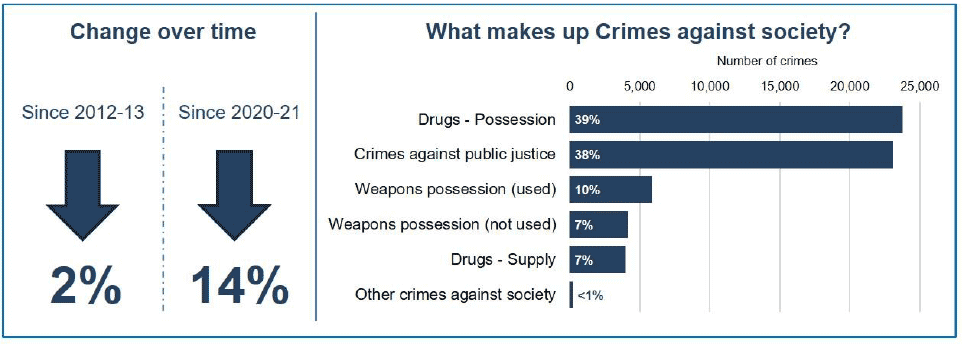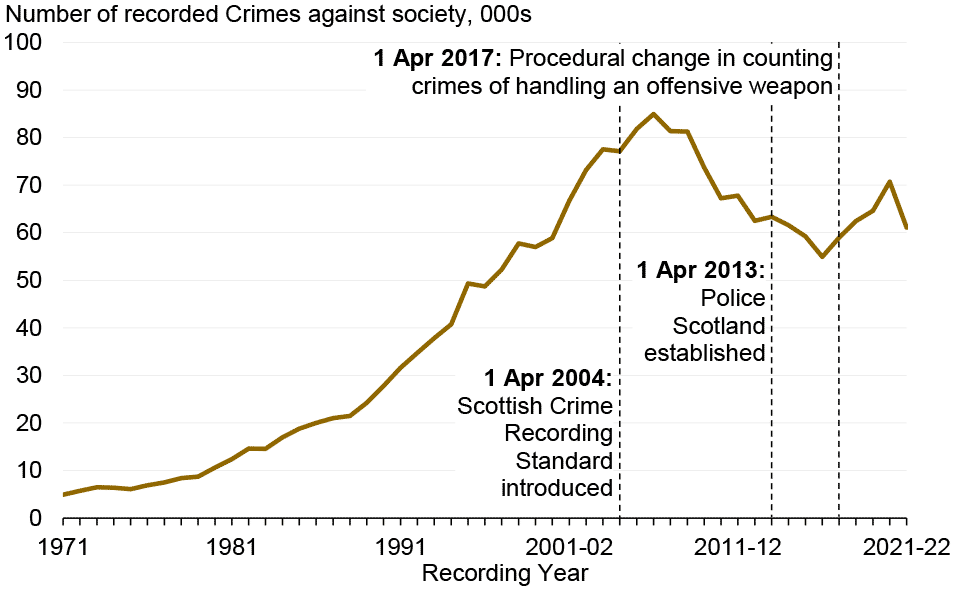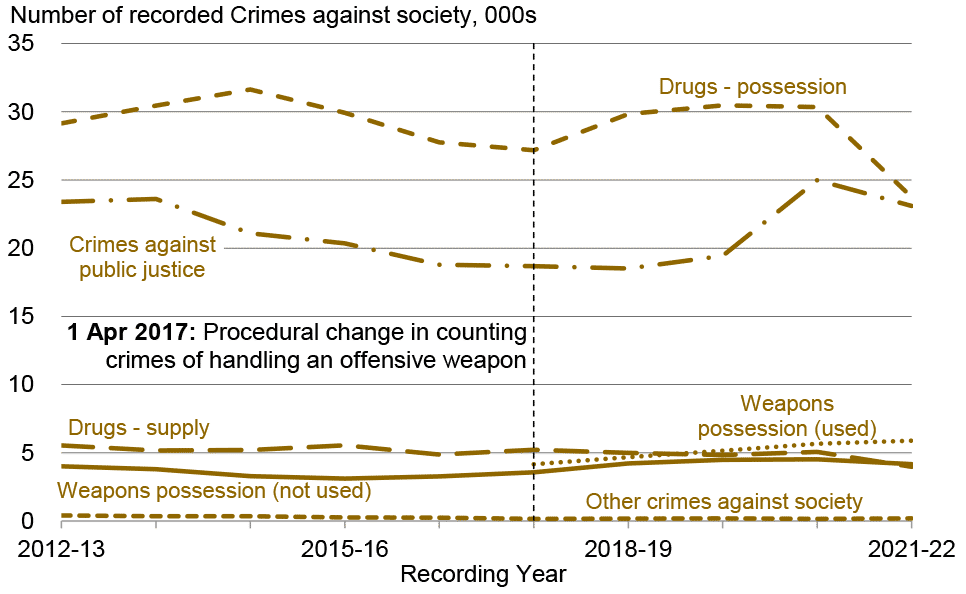Recorded Crime in Scotland, 2021-2022
Statistics on crimes and offences recorded and cleared up by the police in Scotland in 2021-22, split by crime or offence group and by local authority.
Crimes against society

The introduction of the new crime grouping structure sees a change of name for the previous ‘Other crimes’ group to Crimes against society. Beyond this, the only other change was the splitting of the Drugs category into two new categories: Drugs – Possession and Drugs – Supply.
Crimes against society accounted for 21% of all crimes recorded in Scotland in 2021-22. Between 2020-21 and 2021-22, the number of Crimes against society recorded by the police decreased by 14%, from 70,737 to 61,059. This fall is mostly driven by decreases in the recording of Drugs – Possession and Drugs – Supply crimes.
Chart 13 below shows the number of Crimes against society from 1971 onwards. After increasing for a long period up to 2006-07, these crimes decreased until 2016-17, before rising and then falling again over 2020-21 and 2021-22. It should be noted that a key part of the overall increase since 2016-17 is due to a procedural change in the recording of crimes of handling an offensive weapon (see later in this section for further information).

The national rate of recorded Crimes against society was 112 crimes per 10,000 population in 2021-22. This decreased from 129 per 10,000 population in 2020-21.
Chart 14 shows the categories within Crimes against society over the last ten years, and gives an indication of the trend and scale of each category. In 2021-22, of all Crimes against society:
- Drugs – Possession and Crimes against public justice were the largest categories, accounting for 39% and 38%, respectively
- Weapons possession (used) accounted for 10%
- Weapons possession (not used) and Drugs – Supply accounted for 7% each
- Other crimes against society accounted for less than 1%

Note: There was a procedural change to the counting of crimes of handling an offensive weapon in 2017-18. As such, the significant rise in the total number of recorded crimes of handling an offensive weapon shown for that year, does not represent a real increase in these crimes.
The following sections discuss in more detail trends for each crime category comprised in the Crimes against society crime group. These are:
- Crimes against society
- Crimes against public justice
- Weapons possession (not used)
- Weapons possession (used)
- Drugs – Supply
- Drugs – Possession
- Other crimes against society
Further details on some categories can be found in the 'Supporting documents' Excel workbook.
Crimes against public justice
Crimes against public justice accounted for 38% of Crimes against society. These cover a range of crimes, including Bail offences, Resisting arrest and General attempts to pervert the course of justice.
Over the ten year period from 2012-13 to 2021-22 the number of crimes recorded in this category decreased by 1%. There was a 7% decrease in the most recent year, from 24,985 recorded in 2020-21 to 23,099 in 2021-22. This followed a large increase between 2019-20 and 2020-21, which was likely due to the circumstances caused by the COVID-19 pandemic.
Handling offensive weapons
In 2017-18 the Scottish Crime Recording Board made a procedural change to how some crimes of handling an offensive weapon were recorded. This has had an impact on the comparability of the recorded crime statistics before and after this point.
Prior to 2017-18, statistics on handling offensive weapons in public places only include incidents where the perpetrator did not commit further crimes with the weapon. If they had, the specific crime of handling an offensive weapon was considered an aggravation of the crime it was used to commit (for example an aggravated assault) and would not have been included in the statistics.
From 1 April 2017, crimes of handling offensive weapons in public places are no longer treated as an aggravation where they are used to commit other crimes or offences against a person. As such, both the crime of handling an offensive weapon in a public place and any crime or offence committed with it are now both included in the statistics. This change was made to improve consistency between the recording of these crimes and the criminal law.
As a result of this change, crimes of handling an offensive weapon have been substantially higher since 2017-18. This does not represent a real increase in recorded crime. This change will continue to have an impact on the comparability of recorded crime statistics for all years prior to 2017-18.
From 2017-18, crimes of handling an offensive weapon in Scotland can then be counted in two different ways:
- the first is to use the pre-existing statistics, where the offensive weapon has not been used to commit another crime or offence against a person in a public place
- the second is to look at crimes where the offensive weapon was used to commit another crime or offence against a person in a public place
In June 2018 a report was published that presented more detailed information on the handling of offensive weapons within public places in Scotland. This included findings on the characteristics of these cases, based on a random sample of 1,500 crimes recorded by the police for the first six months (April to September) of 2013 and 2017. More information can be found by accessing the ‘Recorded Crime in Scotland: Handling Offensive Weapons’ publication.
Weapons possession – Not used in other crimes or offences
The crime of Weapon possession (not used) accounted for 7% of Crimes against society in 2021-22.
Over the ten year period from 2012-13 to 2021-22 the number of crimes recorded in this category increased by 4% (from 4,015 to 4,160). However, there was an 8% decrease in the most recent year, from 4,524 in 2020-21 to 4,160 in 2021-22.
In 2021-22, 176 crimes of handling an offensive weapon (not used) occurred within a prison, compared to 123 in 2020-21.
In 2021-22, 126 crimes of handling an offensive weapon (not used) occurred within a school. This compares to 74 in 2020-21. It should be noted that schools were closed for a considerable part of the 2020-21 school year, which may have had an impact on the figure for 2020-21. This should be taken into consideration when interpreting these statistics.
Weapons possession – Used in other crimes or offences
The crime of Weapon possession (used) accounted for 10% of Crimes against society in 2021-22.
There was a 4% increase in the most recent year, from 5,660 crimes recorded in 2020-21 to 5,888 in 2021-22.
In 2021-22, 80 crimes of handling an offensive weapon (used) occurred within a prison, compared to 81 in 2020-21.
In 2021-22, 102 crimes of handling an offensive weapon (used) occurred within a school, compared to 36 in 2020-21. It should be noted that schools were closed for a considerable part of the 2020-21 school year, which may have had an impact on the figure for 2020-21. This should be taken into consideration when interpreting these statistics.
Drugs – Supply
Crimes related to the Supply of Drugs accounted for 7% of Crimes against society. Over the ten year period from 2012-13 to 2021-22 the number of crimes recorded in this category decreased by 28%. This includes a 22% decrease in the most recent year, from 5,066 in 2020-21 to 3,976 in 2021-22.
Drugs – Possession
Crimes of Possession of Drugs accounted for 39% of Crimes against society, the largest category in 2021-22. Over the ten year period from 2012-13 to 2021-22 the number of crimes recorded in this category has decreased by 19%. There was a 22% decrease in the most recent year, from 30,344 crimes in 2020-21 to 23,747 in 2021-22.
Other crimes against society
Other crimes against society accounted for less than 1% of all Crimes against society. This category includes Treason, Conspiracy, Explosive offences, Wrecking, piracy and hijacking, and Crimes against public order.
Over the ten year period from 2012-13 to 2021-22 the number of crimes recorded in this category decreased by 54%. There was a 20% increase in the most recent year, from 158 crimes recorded in 2020-21 to 189 in 2021-22.
Contact
Email: Justice_Analysts@gov.scot
There is a problem
Thanks for your feedback